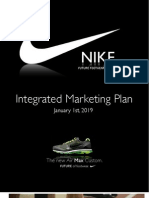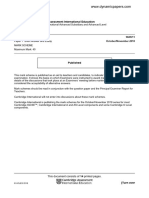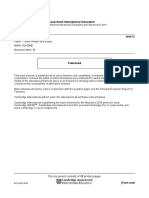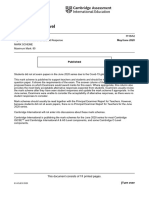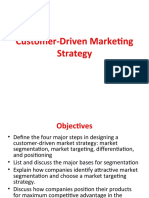Cambridge Assessment International Education: Business 9609/11 October/November 2017
Cambridge Assessment International Education: Business 9609/11 October/November 2017
Uploaded by
RuslanCopyright:
Available Formats
Cambridge Assessment International Education: Business 9609/11 October/November 2017
Cambridge Assessment International Education: Business 9609/11 October/November 2017
Uploaded by
RuslanOriginal Title
Copyright
Available Formats
Share this document
Did you find this document useful?
Is this content inappropriate?
Copyright:
Available Formats
Cambridge Assessment International Education: Business 9609/11 October/November 2017
Cambridge Assessment International Education: Business 9609/11 October/November 2017
Uploaded by
RuslanCopyright:
Available Formats
Cambridge Assessment International Education
Cambridge International Advanced Subsidiary and Advanced Level
BUSINESS 9609/11
Paper 1 Short Answer/Essay October/November 2017
MARK SCHEME
Maximum Mark: 40
Published
This mark scheme is published as an aid to teachers and candidates, to indicate the requirements of the
examination. It shows the basis on which Examiners were instructed to award marks. It does not indicate the
details of the discussions that took place at an Examiners’ meeting before marking began, which would have
considered the acceptability of alternative answers.
Mark schemes should be read in conjunction with the question paper and the Principal Examiner Report for
Teachers.
Cambridge International will not enter into discussions about these mark schemes.
Cambridge International is publishing the mark schemes for the October/November 2017 series for most
Cambridge IGCSE®, Cambridge International A and AS Level components and some Cambridge O Level
components.
® IGCSE is a registered trademark.
This document consists of 10 printed pages.
© UCLES 2017 [Turn over
9609/11 Cambridge International AS/A Level – Mark Scheme October/November
PUBLISHED 2017
Question Answer Marks
1(a) Define the term ‘channel of distribution’. 2
It is the chain of intermediaries a product passes through (1) from producer
to consumer. (1)
A definition such as this merits 2 marks.
A partial definition such as ‘the way a business distributes its products’ or
‘method used by a business to get products to customers’ merits 1 mark.
Sound definition (2 marks)
Partial definition – limited understanding (1 mark)
No creditable content (0 marks)
1(b) Briefly explain two factors a manufacturing business might consider in 3
deciding on an appropriate channel of distribution.
Answers may include:
• cost of different distribution channels e.g. direct selling involves
shipping costs and requires the manufacturer to hold inventory.
• using intermediaries means reduced profits for the manufacturer.
• efficiency of distribution channel; which will reach the customer the
quickest and at the lowest cost to the manufacturer.
• which channel gives the manufacturer the control they require over how
the product is presented to the customer.
• type of product – industrial products tend to be sold more directly than
consumer goods, perishable direct to retailers.
• the nature of the chosen market – if it is large and dispersed,
intermediaries may well be needed.
• level of service required or demanded by customers – so some
products will not be sold via internet (e.g. bespoke products).
• technical complexity of the product – may be direct selling, e.g.
computers.
• number of customers – if high value product and few customers, direct
selling might be used (luxury yacht).
NOTE: Some answers refer to methods of transportation but not
specific intermediaries. The question is ‘channel of distribution’ so
methods of transportation only cannot gain marks.
Sound explanation of two factors (3 marks)
Sound explanation of one factor or partial explanation of two factors
(2 marks)
Partial example of one factor or a list of two factors (1 mark)
No creditable content (0 marks)
© UCLES 2017 Page 2 of 10
9609/11 Cambridge International AS/A Level – Mark Scheme October/November
PUBLISHED 2017
Question Answer Marks
2(a) Define the term’ job re-design’. 2
The re-structuring / altering / changing of a job (1), usually with employee
involvement and agreement, (1) to make the work / job more interesting /
satisfying / challenging. (1)
A definition that merits 2 marks will contain 2 of the 3 points listed above.
A partial definition that merits 1 mark will contain 1 of the 3 points above.
NOTE: Some answers refer to the role of an employee changing but do
not refer to a ‘job’ The question is ‘job re-design’ so explicit reference
to a ‘job/tasks’ must be made for marks to be awarded.
Sound definition given (2 marks)
Partial definition given (1 mark)
No creditable content (0 marks)
2(b) Briefly explain the benefits to a business of job re-design. 3
Answers could include:
Job re-design is designed to:
• make the job holder feel more valued by increasing their role. This
leads to maximum output from satisfied workers.
• increase motivation of workers and hence help to retain them so
reducing costs of recruitment.
• create a right person – right job fit leading to efficient and effective
workforce so increasing productivity.
• adapt the business / job roles to suit changing economic conditions,
therefore having the right staff and skills to deal with change so the
business can survive/grow.
NOTE: Candidates that do not refer to a ‘job’ in question 2(a) may
nevertheless give acceptable answers in question 2(b) by referring to
the impact of job re-design on employees such as new skills and
motivation, leading to increased productivity and should be rewarded
accordingly.
Sound explanation of the benefits of job re-design to a business
(3 marks)
Limited explanation of the benefits of job re-design (2 marks)
Some general comment on job re-design (1 mark)
No creditable content (0 marks)
© UCLES 2017 Page 3 of 10
9609/11 Cambridge International AS/A Level – Mark Scheme October/November
PUBLISHED 2017
Question Answer Marks
3 Explain how a business might benefit from acting ethically. 5
Answers may include:
Acting ethically is regarded as doing the ‘right thing’ – taking business
decisions against a background of certain moral principles – morally correct
behaviour.
In the short-term there may be a ‘cost’ involved in acting ethically – only
doing things in a certain way or not doing certain things.
In the long-term there could be substantial benefits:
• avoid negative publicity.
• retain customer loyalty – retain/gain sales through high reputational
perception.
• attract ethical customers/investors.
• attract staff/retain staff.
• gives a competitive advantage.
• improved brand and business awareness.
Effective explanation of possible benefits to a business of ethical business
activities (4–5 marks)
Limited explanation of possible benefits of ethical business activities
(2–3 marks)
Understanding of ethical business activity (1 mark)
No creditable content (0 marks)
4(a) Define the term ‘micro-finance’. 2
The provision of financial services for poor and low-income customers (1)
who do not have access to banking services such as loans and overdrafts
offered by traditional commercial banks. (1)
Such a definition should be awarded 2 marks.
A partial definition such as ‘the provision of financial services to poor
customers’ should be awarded 1 mark.
NOTE: Reference to ‘poor’ or ‘low-income’ must be made for 2 marks
to be awarded.
Sound definition (2 marks)
Partial definition (1 mark)
No creditable content (0 marks)
© UCLES 2017 Page 4 of 10
9609/11 Cambridge International AS/A Level – Mark Scheme October/November
PUBLISHED 2017
Question Answer Marks
4(b) Briefly explain two advantages of micro-finance for entrepreneurs. 3
• entrepreneurs use micro-finance to start businesses.
• entrepreneurs use micro-finance to operate and grow businesses.
• this provides an income and average incomes increase.
• provide finance which otherwise would not be available to high risk
entrepreneurs with no credit score.
• such finance is likely to be at lower interest rates than traditional banks
making it easier to pay back.
• small capital sums in the form of loans to poor aspiring entrepreneurs
(especially in rural areas) have encouraged small businesses to be set
up where previously there was no access to such funds.
• evidence that women, who traditionally have been denied financial
services, have benefitted from micro-finance opportunities.
• growth of local economies; incomes rise and families are able to give
education to their families.
• micro-finance institutions stimulate economic activity and development
particularly through entrepreneurial activity – the multiplier effect.
Sound explanation of two advantages of micro-finance for entrepreneurs (3
marks)
Sound explanation of one advantage or partial explanation of two
advantages (2 marks)
Partial explanation of one advantage or list of two (1 mark)
No creditable content (0 marks)
© UCLES 2017 Page 5 of 10
9609/11 Cambridge International AS/A Level – Mark Scheme October/November
PUBLISHED 2017
Question Answer Marks
5(a) Analyse the role of marketing in adding value to a product 8
Level Description Marks
Good analysis of how marketing can add value to a
4 7–8
product.
Some analysis of how marketing can add value to a
3 5–6
product.
Some application of how marketing can add value to a
2 product or convince customers that a product is more 3–4
desirable.
1 Understanding of value added and/or marketing. 1–2
0 No creditable content. 0
Answers may include:
Candidates may well use the 4Ps framework to answer this question, but
must link to adding value to gain Level 2.
Marketing is linking the production of goods and services to the consumer
profitably and satisfying business and consumer objectives.
Adding value is the difference between the cost of purchasing bought in
materials and the price finished goods/services are sold for – the greater the
difference the greater the potential for more profit.
Marketing / market research / market intelligence can add value by:
• identifying how to get a product to the right customers more
effectively/cheaply so reducing cost and adding value.
• determining the right offer price to set for the target market so creating
the optimal amount of added value for that target market.
• creating a distinctive brand that becomes a ‘must have’ name that
consumers will pay a premium price for.
• increase the perception of this product being more valuable so
customers are willing to pay more for it.
• positioning a business/product/creating a USP so that it stands out from
the competition; customers likely to buy the product even if the price is
higher than rivals.
• creating an exclusive and luxurious retail environment to convince
customers to pay more for a ‘luxurious’ product – cosmetic retailers,
luxury cars.
• using high quality packaging to differentiate a product – perfume –
luxury chocolates and make it appear worth the higher price.
• promoting the benefits of a product to achieve a result / outcome /
emotion – not just a commodity so higher price is justified.
• including testimonials in advertising to suggest social proof that the
product should be bought at the higher price.
© UCLES 2017 Page 6 of 10
9609/11 Cambridge International AS/A Level – Mark Scheme October/November
PUBLISHED 2017
Question Answer Marks
5(b) Discuss how market segmentation could be used to improve the 12
profitability of a hotel.
Level Description Marks
Effective evaluation of how market segmentation could
4 9–12
be used to improve the profitability of a hotel.
Limited evaluation of how market segmentation could
3 7–8
be used to improve the profitability of a hotel.
Analysis and some application of how market
2 segmentation could be used to improve the profitability 3–6
of a hotel.
Understanding of market segmentation and/or
1 1–2
profitability.
0 No creditable content. 0
Answers may include:
• market segmentation – identify different segments within a market and
target different products/services to those segments.
• a customer-focused marketing strategy with the promise of increased
sales and profitability.
• it might lead to gaps in the market being identified and exploited.
• price discrimination can be used to increase revenue and profits.
• profitability – the ability of a business to earn a profit by increasing
revenues and decreasing costs.
NOTE. Some may adopt a ‘macro approach’ and focus on the whole of
the hotel being segmented such as becoming a luxury hotel. This is
acceptable if appropriately discussed.
• Hotel objectives might include – growth, profitability, full occupancy.
• Specific hotel market segments i.e. business traffic during the week,
leisure traffic at weekends, special event traffic (celebrations,
weddings), conference traffic, all ensuring different revenue streams.
• Specific provision could include: luxury penthouse rooms for high-
income earners, family rooms, budget rooms etc. all potentially
generating higher levels of profit.
Evaluative points: increasing hotel facilities to suit different segments
involves costs e.g. refurbishment, staffing, materials. Must be enough
potential revenue to cover this. Depends on existing reputation / location /
competition of hotel as to how successful and therefore profitable, increased
market segmentation might be. Impact on decisions if say an economy goes
into recession.
© UCLES 2017 Page 7 of 10
9609/11 Cambridge International AS/A Level – Mark Scheme October/November
PUBLISHED 2017
Question Answer Marks
6 ‘Location is the most important factor determining the success of a 20
large car manufacturing business.’ Discuss this statement.
Level Description Marks
Effective evaluation of the statement that location is the
5 most important factor determining the success of a 17–20
large car manufacturing business.
Good analysis and limited evaluation of the statement
4 that location is the most important factor determining 13–16
the success of a large car manufacturing business.
Analysis of the statement that location is the most
3 important factor determining the success of a large car 11–12
manufacturing business.
Limited analysis with application of the importance of
2 5–10
business location and business success.
1 Understanding of business location / business success. 1–4
0 No creditable content. 0
Answers may interpret the question in terms of business location generally
within a particular country or area, or relating to a decision to relocate /
diversify, possibly to another country.
Answers may include:
• a discussion of the importance of location to any business (including a
car manufacturing business) – access to skilled labour, raw materials,
transport and communication facilities, governmental support /
incentives / light regulations, proximity to other businesses and
services, customers.
• an understanding that the particular needs and strategies of specific
businesses will affect location decisions and considerations and
influence the significance of particular location issues and decisions.
• a recognition that while location is likely to be a significant success
factor it will not be the only important factor or necessarily the most
important factor.
• other critical success factors determining success will be discussed,
i.e.:
- Operational efficiency – including innovative design, lean /
efficient production processes leading to –
- Product differentiation – distinctive features, ‘bells and whistles’
that lead to distinctive brand attributes leading to –
Customer satisfaction – supported by effective marketing and an
effective response to the demands of existing and emerging market
opportunities.
Strong answers will fully explain the potential contribution made by
‘Location’ to success of a car manufacturing business– but will also
recognise that other factors might be equally / more important such as the 3
set out above and not forgetting the quality of leadership and management
in the business – location is but one important factor.
© UCLES 2017 Page 8 of 10
9609/11 Cambridge International AS/A Level – Mark Scheme October/November
PUBLISHED 2017
Question Answer Marks
7(a) Analyse how a business might use Mintzberg’s roles of management. 8
Level Description Marks
Good analysis of how a business might use Mintzberg’s
4 7–8
roles of management.
Some analysis of how a business might use
3 5–6
Mintzberg’s roles of management.
Some explanation of how a business might use
2 3–4
Mintzberg’s roles of management.
1 Understanding of Mintzberg’s roles of management. 1–2
0 No creditable content. 0
Answers may include:
Mintzberg identified ten roles common to the work of all managers – divided
into three groups:
Interpersonal: Figurehead, Leader and Liaison.
Informational: Monitor, Disseminator and Spokesperson.
Decisional: Entrepreneur, Disturbance Handler, Resource
Allocator and Negotiator.
• allows a business / HRM to analyse the roles that need to be performed
to support the effective management of a business and to identify any
gaps
• acts as a benchmark for drawing up job specifications / recruitment
criteria
• acts as a guide for the content of training and development
programmes
• can be used as evaluative criteria for assessing the performance of
managers
• allows a business to recognise that management roles are varied and
demanding
NOTE. Answers in which the candidate discusses how a manager uses
Mintzberg’s roles and how the result of the manager’s actions affects
the business e.g. achieving objectives, having good working
relationships, etc. are valid and can be fully rewarded.
© UCLES 2017 Page 9 of 10
9609/11 Cambridge International AS/A Level – Mark Scheme October/November
PUBLISHED 2017
Question Answer Marks
7(b) ‘Emotional intelligence is the most important quality of an effective 12
leader.’ Do you agree with this view? Justify your answer.
Level Description Marks
Effective evaluation of the statement that emotional
4 intelligence is the most important quality of an effective 9–12
leader.
Limited evaluation of the statement that emotional
3 intelligence is the most important quality of an effective 7–8
leader.
Analysis and some application of the statement that
2 emotional intelligence is the most important quality of 3–6
an effective leader.
Understanding of emotional intelligence and / or
1 1–2
qualities of leaders.
0 No creditable content. 0
Answers could include:
Effective leadership qualities will be identified such as:
• ability to set a clear vision and direction;
• ability to think strategically and see the big picture;
• motivate and carry staff along in successful achievement of goals;
demonstrate resilience and risk-taking skills;
• inspire followers etc.
Emotional intelligence – Some say EI is more important than IQ.
• ability of leaders to understand their own emotions and those of others
to achieve business performance;
• the ability to understand people and to get staff to respond through
respect and understanding;
• authentic leadership and servant leadership
• Goleman’s EI competencies: self-awareness; self-management; social
awareness; social skills.
The relative importance of emotional intelligence –
• how does EI complement and support other leadership qualities?
• without EI leaders may not gain the confidence of employees.
• ‘soft is hard’ in business leadership but it would be risky not to expect a
balance and variety of qualities from an effective business leader.
Evaluative comment/judgement of the view stated. EI may be one of a
number of important qualities required of an effective leader. The balance
within the cluster of qualities may well be critical, as would the specific
needs of a business at particular times.
© UCLES 2017 Page 10 of 10
You might also like
- Project Report On KFCDocument60 pagesProject Report On KFCSiavash Wared75% (44)
- Case 3 Dr. Beckett's Dental Office - Course Hero (Part 1)Document11 pagesCase 3 Dr. Beckett's Dental Office - Course Hero (Part 1)Huey DoanNo ratings yet
- Integrated Marketing Plan PDFDocument14 pagesIntegrated Marketing Plan PDFimcharles100% (1)
- 9609 w16 Ms 11Document8 pages9609 w16 Ms 11Mohammed NaimNo ratings yet
- Cambridge International Examinations: Business 9609/13 May/June 2017Document10 pagesCambridge International Examinations: Business 9609/13 May/June 2017Nisar AhmedNo ratings yet
- Cambridge Assessment International Education: Business 9609/12 October/November 2017Document10 pagesCambridge Assessment International Education: Business 9609/12 October/November 2017lushandalpadadoNo ratings yet
- Cambridge International Examinations: Business 9609/12 May/June 2017Document11 pagesCambridge International Examinations: Business 9609/12 May/June 2017AbdulBasitBilalSheikhNo ratings yet
- Cambridge Assessment International Education: Business 9609/12 October/November 2018Document14 pagesCambridge Assessment International Education: Business 9609/12 October/November 2018Low JeNo ratings yet
- Cambridge International AS & A Level: Business 9609/12 October/November 2020Document15 pagesCambridge International AS & A Level: Business 9609/12 October/November 2020Jawad NadeemNo ratings yet
- Cambridge Assessment International Education: Business 9609/11 October/November 2019Document15 pagesCambridge Assessment International Education: Business 9609/11 October/November 2019skaugfdgvwafNo ratings yet
- 9609 s19 Ms 12Document12 pages9609 s19 Ms 12Hashir Naveed MirzaNo ratings yet
- Cambridge IGCSE™: Business Studies 0450/11 October/November 2020Document20 pagesCambridge IGCSE™: Business Studies 0450/11 October/November 2020Year 9No ratings yet
- Cambridge Assessment International Education: Business 9609/11 October/November 2018Document14 pagesCambridge Assessment International Education: Business 9609/11 October/November 2018Low JeNo ratings yet
- Cambridge O Level: Business Studies 7115/11 October/November 2020Document20 pagesCambridge O Level: Business Studies 7115/11 October/November 2020r3za_5008No ratings yet
- Cambridge Assessment International Education: Business 9609/11 October/November 2018Document14 pagesCambridge Assessment International Education: Business 9609/11 October/November 2018RuslanNo ratings yet
- A. 9609 w23 Ms 11-Pages-DeletedDocument23 pagesA. 9609 w23 Ms 11-Pages-Deletedomoto.2006No ratings yet
- 9609 MW ScriptB P1 MSDocument12 pages9609 MW ScriptB P1 MS章琳雯No ratings yet
- As Business Mark Schemes 2020 - CompressedDocument826 pagesAs Business Mark Schemes 2020 - CompressedjeandreNo ratings yet
- Cambridge IGCSE™: Business Studies 0450/12 October/November 2020Document21 pagesCambridge IGCSE™: Business Studies 0450/12 October/November 2020سعدیNo ratings yet
- CSEC Qualitative Analysis CATIONSDocument24 pagesCSEC Qualitative Analysis CATIONS-Sabiraaa -No ratings yet
- 9609 m16 Ms 12 PDFDocument9 pages9609 m16 Ms 12 PDFViviana CorneteanuNo ratings yet
- Cambridge O Level: Business Studies 7115/12 October/November 2020Document21 pagesCambridge O Level: Business Studies 7115/12 October/November 2020r3za_5008No ratings yet
- Cambridge International AS & A Level: Business 9609/11 May/June 2020Document14 pagesCambridge International AS & A Level: Business 9609/11 May/June 2020VinayakNo ratings yet
- Cambridge International Advanced Subsidiary and Advanced LevelDocument9 pagesCambridge International Advanced Subsidiary and Advanced LevelShrikhaNo ratings yet
- Cambridge Assessment International Education: Business 9609/13 May/June 2019Document12 pagesCambridge Assessment International Education: Business 9609/13 May/June 2019AbdulBasitBilalSheikhNo ratings yet
- 9609 s16 QP 12 PDFDocument4 pages9609 s16 QP 12 PDFHeena Kaur50% (2)
- 9609 s16 Ms 12Document10 pages9609 s16 Ms 12Sathya ViswanathanNo ratings yet
- Cambridge International Advanced Subsidiary and Advanced LevelDocument92 pagesCambridge International Advanced Subsidiary and Advanced LevelHassan ShahidNo ratings yet
- Cambridge International AS & A Level: Business 9609/12 May/June 2020Document13 pagesCambridge International AS & A Level: Business 9609/12 May/June 2020Oceane ArmoogumNo ratings yet
- 9609 w17 Ms 22Document19 pages9609 w17 Ms 22mrsundeepsNo ratings yet
- Published Answer Marks Identify One Element of The Triple Bottom Line. 1Document14 pagesPublished Answer Marks Identify One Element of The Triple Bottom Line. 1Abirami BrabuNo ratings yet
- Cambridge International Examinations Cambridge International Advanced Subsidiary and Advanced LevelDocument9 pagesCambridge International Examinations Cambridge International Advanced Subsidiary and Advanced LevelNathania PriscillaNo ratings yet
- 9609 MW ScriptAC P1 MSDocument14 pages9609 MW ScriptAC P1 MS章琳雯No ratings yet
- Answer For As Level Past PaperDocument14 pagesAnswer For As Level Past PaperReddy Girinath100% (1)
- Cambridge IGCSE™: Business Studies 0450/13 October/November 2020Document20 pagesCambridge IGCSE™: Business Studies 0450/13 October/November 2020ESHMEET KAUR MALHOTRANo ratings yet
- Cambridge International AS & A Level: Business 9609/12 March 2020Document17 pagesCambridge International AS & A Level: Business 9609/12 March 2020Ayush OjhaNo ratings yet
- Cambridge Assessment International Education: Business Studies 0450/23 May/June 2018Document13 pagesCambridge Assessment International Education: Business Studies 0450/23 May/June 2018Ayesha JagotNo ratings yet
- 9609 m17 Ms 22Document11 pages9609 m17 Ms 22kazamNo ratings yet
- Cambridge IGCSE™: Business Studies 0450/12 October/November 2020Document21 pagesCambridge IGCSE™: Business Studies 0450/12 October/November 2020Bhone TheinKhaKyawNo ratings yet
- Mark Schdeme - 13Document15 pagesMark Schdeme - 13bmensahgms2No ratings yet
- Cambridge O Level: Business Studies 7115/12 May/June 2020Document12 pagesCambridge O Level: Business Studies 7115/12 May/June 2020Fred SaneNo ratings yet
- Cambridge International AS & A Level: Business 9609/23 May/June 2020Document11 pagesCambridge International AS & A Level: Business 9609/23 May/June 2020Rinnah TeklayNo ratings yet
- Cambridge International Examinations: Business Studies 0450/22 March 2017Document12 pagesCambridge International Examinations: Business Studies 0450/22 March 2017Wambui KahendeNo ratings yet
- ACCT 3102 - Assignment 1Document3 pagesACCT 3102 - Assignment 1Iqtidar KhanNo ratings yet
- Cambridge IGCSE™ (9-1) : Business Studies 0986/12 May/June 2020Document11 pagesCambridge IGCSE™ (9-1) : Business Studies 0986/12 May/June 2020Viral TiktoksNo ratings yet
- Cambridge IGCSE™: Business Studies 0450/22 March 2020Document15 pagesCambridge IGCSE™: Business Studies 0450/22 March 2020Aryan AgarwalNo ratings yet
- Cambridge International Examinations: Business 9609/22 March 2017Document11 pagesCambridge International Examinations: Business 9609/22 March 2017RuslanNo ratings yet
- Cambridge International Advanced Subsidiary and Advanced LevelDocument4 pagesCambridge International Advanced Subsidiary and Advanced LevelEffective StudyNo ratings yet
- Cambridge IGCSE™: Business Studies 0450/13 October/November 2020Document20 pagesCambridge IGCSE™: Business Studies 0450/13 October/November 2020Wilfred BryanNo ratings yet
- Cambridge International Examinations Cambridge International General Certificate of Secondary EducationDocument16 pagesCambridge International Examinations Cambridge International General Certificate of Secondary Educationfoxfell2006No ratings yet
- Soal UAS Online English For Management 2 - Sabtu 12.00-14.30Document3 pagesSoal UAS Online English For Management 2 - Sabtu 12.00-14.30nurainiNo ratings yet
- 9707 s12 Ms 13Document7 pages9707 s12 Ms 13Muhammad Salim Ullah KhanNo ratings yet
- Cambridge International Examinations: Business Studies 0450/12 March 2017Document11 pagesCambridge International Examinations: Business Studies 0450/12 March 2017Zhi En LeeNo ratings yet
- Cambridge Assessment International Education: Business 9609/11 May/June 2018Document12 pagesCambridge Assessment International Education: Business 9609/11 May/June 2018Dhrisha GadaNo ratings yet
- Cambridge International Advanced Subsidiary and Advanced LevelDocument4 pagesCambridge International Advanced Subsidiary and Advanced LevelDavidNo ratings yet
- Maximum Mark: 60: Cambridge International Advanced Subsidiary and Advanced LevelDocument8 pagesMaximum Mark: 60: Cambridge International Advanced Subsidiary and Advanced Leveltafadzwa tandawaNo ratings yet
- June 2016 Paper 3 Mark Scheme 9609Document12 pagesJune 2016 Paper 3 Mark Scheme 9609Lejla Eminovic Niksic0% (1)
- wbs12 01 Rms 20220818Document22 pageswbs12 01 Rms 20220818fnickNo ratings yet
- Cambridge IGCSE™: Business Studies 0450/11 May/June 2020Document10 pagesCambridge IGCSE™: Business Studies 0450/11 May/June 2020Daniel NAMNo ratings yet
- Question PapaerDocument4 pagesQuestion Papaerbmensahgms2No ratings yet
- Cie Paper 1 Past QuestionsDocument160 pagesCie Paper 1 Past Questionszzw46318No ratings yet
- 9707 s13 Ms 21Document5 pages9707 s13 Ms 21lexyaNo ratings yet
- Executive SummaryDocument12 pagesExecutive Summaryaleezashiek0% (1)
- Tourism and Hospitality Marketing FINALDocument39 pagesTourism and Hospitality Marketing FINALJane Charlotte RedondoNo ratings yet
- Marketing Strategies Term Project OutlineDocument3 pagesMarketing Strategies Term Project OutlinesaaaruuuNo ratings yet
- "4 Wheels" - Automobile Repair & MaintenanceDocument38 pages"4 Wheels" - Automobile Repair & MaintenanceAli TahtahNo ratings yet
- MM QuizDocument9 pagesMM QuizSanjay VinceNo ratings yet
- Marketing Plan For Samsung EssayDocument7 pagesMarketing Plan For Samsung EssayAmi ImranNo ratings yet
- Tutorial Essay Questions Week 5Document7 pagesTutorial Essay Questions Week 5Kezia Maria NPNo ratings yet
- Fashion Retailing: Comparision of Retail StrategyDocument18 pagesFashion Retailing: Comparision of Retail StrategyKumar GauravNo ratings yet
- 16 Mark MarkeingggggDocument19 pages16 Mark Markeingggggjawaharkumar MBANo ratings yet
- Bc0200050 Marketing Management ProjectDocument15 pagesBc0200050 Marketing Management ProjectUdhithaa S K KotaNo ratings yet
- Segmentation Targeting and Positioning S PDFDocument9 pagesSegmentation Targeting and Positioning S PDFdishaNo ratings yet
- DIGM4375: Packaging Design: Spring 2017Document9 pagesDIGM4375: Packaging Design: Spring 2017Anonymous fJ0nUP0L3No ratings yet
- PRINCIPLES OF MARKETING-Q1-M1-Torejas, Vanessa LouDocument31 pagesPRINCIPLES OF MARKETING-Q1-M1-Torejas, Vanessa LouGraciously ElleNo ratings yet
- Grand Finale: Rapunzel ShampooDocument60 pagesGrand Finale: Rapunzel ShampooDevyani BehlNo ratings yet
- Business PlanDocument29 pagesBusiness PlanShuvro Kumar Paul100% (1)
- Customer-Driven Marketing StrategyDocument66 pagesCustomer-Driven Marketing Strategyswatiskhuraniya100% (3)
- Pool Items 1,3,4Document5 pagesPool Items 1,3,4tayyeong21No ratings yet
- CHAPTER 3 Feasibility AnalysisDocument54 pagesCHAPTER 3 Feasibility Analysissitimutmainah44No ratings yet
- RMIT Assignment On MarketingDocument19 pagesRMIT Assignment On MarketingMaleesha FernandoNo ratings yet
- Grewal6ce PPT Ch06 Fall 2023Document45 pagesGrewal6ce PPT Ch06 Fall 2023PRAkriT POUdeLNo ratings yet
- Chap 11 Marketing ManagementDocument13 pagesChap 11 Marketing ManagementKhant ReenaNo ratings yet
- Marketing Plan TemplateDocument34 pagesMarketing Plan Templateyash_28No ratings yet
- Kotler Pom17e PPT 01 OutputDocument33 pagesKotler Pom17e PPT 01 OutputadarshNo ratings yet
- Executive SummaryDocument15 pagesExecutive SummaryDineeka HimashiNo ratings yet
- Barclays Case Study Feb 2014Document4 pagesBarclays Case Study Feb 2014Ali AbdurahimanNo ratings yet
- IC Simple Business Plan 10785 WORD 0Document13 pagesIC Simple Business Plan 10785 WORD 0InformationNo ratings yet
- Cadbury ProjectDocument20 pagesCadbury Projectsandycandy9993913No ratings yet



